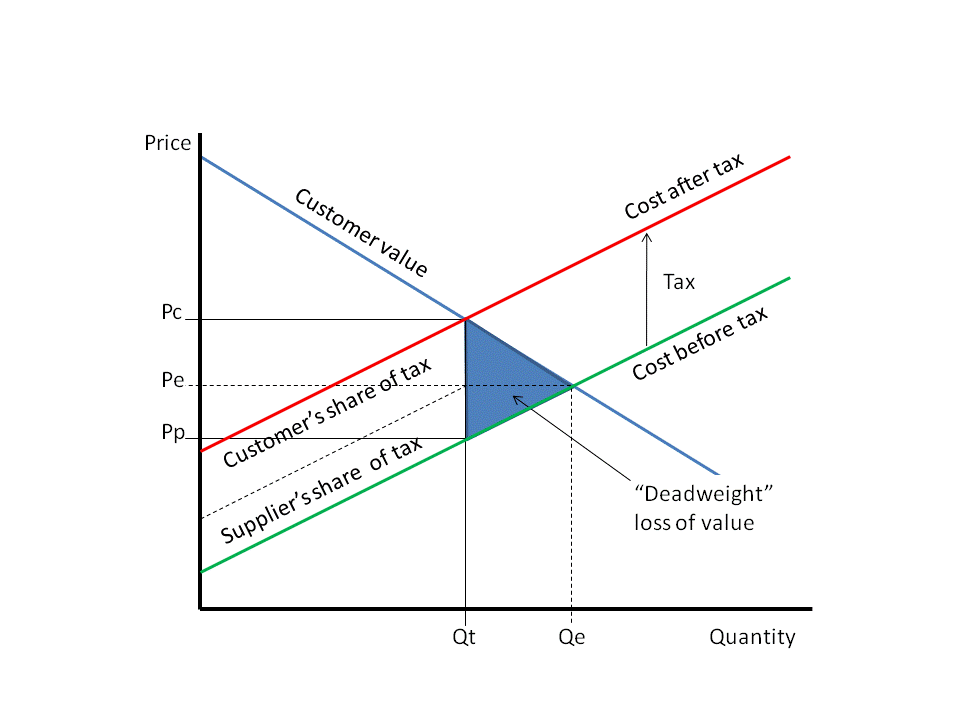Deadweight Loss Calculator
The deadweight loss calculator helps you understand and calculate the economic cost to society when external factors impact market prices.
These factors include market regulations by policymakers through taxes, subsidies, and minimum wage laws. They can also be when prices are artificially pushed out of their natural supply and demand equilibrium by government-imposed price ceilings and price floors or by a monopoly controlling the supply of goods in a market.
Read on if you want to know what deadweight loss is and how to calculate it.
What is deadweight loss?
To understand the deadweight loss definition, let's first observe some general economic concepts:
In an unregulated and monopoly-free market, where prices are naturally set by supply and demand, the total economic welfare generated by that market is equal to the sum of what we call the consumer surplus and the producer surplus. We described the former in more detail in the consumer surplus calculator.
The consumer surplus is the difference between what consumers were willing and able to pay, and what they actually paid for their product or service. The producer surplus is the difference between what producers were willing and able to supply their product or service for, and the price that they actually got for that product or service. It is related to the break-even point, which we introduced in the break-even calculator.
The total economic welfare of a market can be seen as the total amount of positive value created for society by all the transactions of that market. When you’re in a free-market equilibrium, the sum of consumer and producer surplus is as large as possible — you have the best economic efficiency and the highest total economic welfare.
Now let’s consider that the price of that product or service was artificially regulated to a different value because of external effects like a government tax or subsidy, a minimum wage law, or a monopoly controlling the supply and inflating the price to maximize its profits (you can analyze the best price with the optimal price calculator).
The deadweight loss definition tells us that, although those cases have different effects on the parties involved, their total economic welfare is always less than the one generated by a free and unregulated market. This loss in total economic welfare is what we call the deadweight loss.
How to calculate deadweight loss?
Now that we know what deadweight loss is, let's see how to calculate the deadweight loss in a market.
The deadweight loss formula can be derived from the deadweight loss graph based on the supply and demand curves. To do so, one must examine the effects of a shift in price from its natural equilibrium on the surplus and loss areas of all market players. The price elasticity of demand calculator might be handy for this case.
In the deadweight loss graph below, the deadweight loss is represented by the area of the blue triangle, which is equal to the price difference (base of the triangle) multiplied by the quantity difference (height of the triangle), divided by 2.

The resulting deadweight loss formula is:
where:
- — Deadweight loss;
- — Original price;
- — New price;
- — Original quantity; and
- — New quantity.
Now that we have learned how to calculate deadweight loss, we can see from this deadweight loss formula that the more the new price deviates from the original one, the greater the deadweight loss. Furthermore (and this usually goes hand in hand with the price difference), the more the new quantity differs from the original one, the higher the deadweight loss.
Using the deadweight loss calculator
Our deadweight loss calculator allows you to estimate the deadweight loss of a market in four simple steps:
- Enter the original free-market price of the product in the field "Original price".
- Fill in the new price of the product in the field "New price".
- Input the original, sold quantity of the product in the field "Original quantity".
- Enter the new sold quantity of the product in the field "New quantity".
The calculator will give you the deadweight loss in the field Deadweight loss.
For example, let’s say that under free, unregulated, and unmanipulated market conditions, the price of organic apples was $1 per pound, and the yearly volume of organic apple sales was 500 million pounds.
The government granted a subsidy on organic products that pushed the price of organic apples down to $0.9 per pound and the sales volume up to 530 million pounds. Under the new market conditions, the consumers and the producers both profited from the new measure, but the government incurred the cost — a cost greater than the consumer and producer surpluses combined.
The overall economic welfare of the country decreased by an amount equal to the deadweight loss.
To calculate this loss, we type 1 in the field "Original price", 0.9 in the field "New price", 500 in the field "Original quantity", and 530 in the field "New quantity". The calculator gives us our deadweight loss value of $1.5 million in the field Deadweight loss.
You might also be interested in other topics. Check, for example, the GDP calculator to analyze the gross domestic product with us.